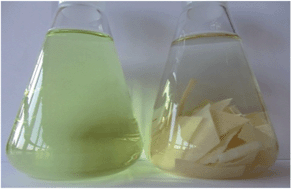Polyvinylamine modified polyester fibers – innovative textiles for the removal of chromate from contaminated groundwater†
Abstract
The soil and groundwater of many old industrial areas are polluted by different environmental hazards. Because of their high toxicity and carcinogenic potential, chromate contaminations are especially problematic and a complete cleanup of such areas is necessary to avoid fatal environmental and sanitary impacts. Conventionally, decontamination is carried out by the removal of the soil and a long-term filtration of groundwater with various chromate-adsorbing materials over a period of many years. Efficient, reusable and cheap adsorbing materials, however, are still missing. Here, we present a new, cheap and reusable chromate-adsorbing substrate based on polyvinylamine-coated polyester fibers. The surface modification of the fibrous material is realized by common methods in textile finishing yielding a durable, high-performing and reusable adsorbent for water-dissolved chromate. The functionalized nonwoven fabric has a high binding capacity for chromate and the chromate concentration of highly polluted waters (with concentrations around 50 mg L−1) can easily be decreased below the limit of 50 μg L−1 recommended by the WHO. Moreover, the material is reusable after regeneration under aqueous alkaline conditions. The adsorption properties at different pH values were determined with different adsorption models. In addition, adsorption kinetics were evaluated using artificial and real life chromate-contaminated water samples.


 Please wait while we load your content...
Please wait while we load your content...